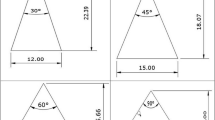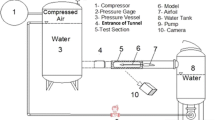Abstract
Ventilated cavitation has been successfully employed as ship drag reduction technology and potentially can mitigate flow-induced vibration. The obtained successes were based on solutions of design problems considered in the framework of ideal fluid theory with their following validation by towing tank tests. However, various aspects of the interaction of ventilated cavities with the viscous flows around the ship hulls remain unclear, whereas there is usually no possibility to simultaneously keep the full-scale Froude number and cavitation number in the test facilities. So, the further progress of the application of ventilated cavitation substantially depends on the ability of computational tools to predict this interaction. This paper briefly describes the state-of-the-art computation of ventilated cavitation and points out the most challenging unsolved problems that appeared in the model tests (prediction of air demand by cavities, ventilation effect on ship drag, on hydrofoil lift, and on the propagation of shock waves in cavities).




















Similar content being viewed by others
References
Abolfazl S, Leer-Anderson M, Bensow RE, Norrby J (2012) Hydrodynamics of a displacement air cavity ship, 29th Symp. Naval Hydrodynamics, Gothenburg, Sweden
Al’tshuler LV, Bakanova AA (1969) Electronic structure and compressibility of metals at high pressures. Sov Phys Usp v11:678–689
Amromin EL (1990) On the nature of threshold velocity for cavitation erosion, Scientific and Methodological Seminar on Ship Hydrodynamics, Varna, Bulgaria
Amromin EL (2007) Analysis of body supercavitation in shallow water. Ocean Eng 34:1602–1606
Amromin EL (2018) Ship bottom cavity as shock absorber in waves. J Mar Sci Appl 17:173–177. https://doi.org/10.1007/s11804-018-0019-3
Amromin EL, Arndt REA (2019) Analysis of influence of cavity content on flow pulsations. Int J Multiphase Flow 110:108–117
Amromin EL, Kopriva J, Arndt REA, Vosnik M (2006) Hydrofoil drag reduction by partial cavitation. ASME J Fluids Engineering 128:931–936
Amromin EL, Metcalf B, Karafiath G (2011) Synergy of resistance reduction effects for a ship with bottom air cavity. ASME J Fluids Engineering 133:021302(1)–021302(7)
Arndt REA, Hambleton J, Kawakami E, Amromin EL (2009) Creation and maintenance of cavities under horizontal surfaces. ASME J Fluids Engineering 131:111301(1)–111301(10)
Basin A, Butuzov A, Ivanov A, Olenin Y, Petrov V, Potapov O, Ratner E, Starobinsky V, Eller A (1969) Operational tests of a cargo ship ‘XV VLKSM congress’ with air injection under a bottom. River Transport:52–53 in Russian
Butuzov AA (1966) Extreme parameters of vented cavity on the top surface of horizontal wall. Fluids Dynamics:167–170
Butuzov AA, Gorbachev YN, Ivanov AN, Kaluzhny VG, Pavlenko AN (1990) Ship drag reduction by artificial gas cavities. Sudostroenie 11:3–6 in Russian
Choi J-K, Chahine GL (2010) Numerical study on the behavior of air layers used for drag reduction. 28 th Symp Naval Hydrodynamics, Pasadena, California, USA
Compendium on naval hydrodynamics (2015) Paris, France: ENSTA
Courant R, Friederichs KO (1948) Supersonic flow and shock waves. Interscience Publ, NY
Courouble M (1971) Recherche sur une technique de reduction de la résistance a la marche des navires lents. ATMA-1971 Conf, Paris (in French)
Coutier-Delgosha O, Devillers J-F, Pichon T (2006) Internal structure and dynamics of sheet cavitation. Phys Fluids 18:017103. https://doi.org/10.1063/1.2149882
Foeth EJ (2008) Decreasing of frictional resistance by air lubrication. 20 th Int Symposium on Yacht Design and Yacht Construction, Amsterdam, NL
Ganesh H, Makiharju SA, Ceccio SL (2016) Bubbly shock propagation as a mechanism for sheet-to-cloud transition of partial cavities. J Fluid Mech 802:37–78
Gorbachev YN, Amromin EL (2012) Ship drag reduction by ventilation from Laval to near future: challenges and successes. Conference of Association Technique Maritime et Aeronoutique, Paris
Gorbachev YN, Sverchkov AV, Galushina MV (2015) Propulsion of displacement ships with the single bottom cavities. Sudostroenie 1:17–23 in Russian
Gurevich MI (1970) Theory of jets in ideal fluids. AC Press, NY
Ji B, Luo X, Peng X, Zhang Y, Y-l W, Xu H (2010) Numerical investigation of the ventilated cavitating flow around an underwater vehicle based on a three-component cavitation model. J Hydrodyn 22:753–759
Jian W, Petkovšek M, Houlin L, Širok B, Dular M (2015) Combined numerical and experimental investigation of the cavitation erosion process. ASME J Fluids Eng 137:051302
Kim S-E (2015) Progress in numerical simulation of turbulent cavitating flow in an axial waterjet pump. J Phys Conf Ser 656:012064
Kinzel MP, Lindau JW, Peltier J, Zajaczkowski F, Arndt REA, Wosnik M, Mallison T (2007) Computational investigation of air entrainment, hysteresis and loading for large-scale, buoyant cavities. NMSH2007 Conf, Ann Arbor, 3, 306
Knapp RT, Daily JW, Hammitt FG (1970) Cavitation, McGraw-Hill
Kopriva J, Amromin EL, Arndt REA, Kovinskaya SI (2007) High performance partially cavitating hydrofoils. J Ship Res 51:313–325
Kubota A, Kato H, Yamagushi H (1992) A new modeling of cavitating flows: a numerical study of unsteady cavitation of a hydrofoil section. J Fluid Mech 240:59–96
Kuklinski R, Henoch C, Castano J (2001) Experimental studies of ventilated cavities on dynamic test model. Cav-2001 Symposium, Pasadena
Latorre R (1997) Ship hull drag reduction using bottom air injection. Ocean Eng 24:161–175
Liu T, Huang B, Wang G, Zang M (2018) Experimental investigation of ventilated partial cavitating flows with special emphasis on flow pattern regime and unsteady shedding behavior around an axisymmetric body at different angles of attack. Ocean Eng 147:289–303
Long Y, Long X, Ji B, Huai W, Qian Z (2017) Verification and validation of URANS simulations of the turbulent cavitating flow around the hydrofoil. J Hydrodyn 29:610–620
Mäkiharju S, Elbing BR, Wiggins A, Dowling DR, Perlin M, Ceccio SL (2010) Perturbed partial cavity drag reduction at high Reynolds numbers. 28 th Sym. Naval Hydrodynamics, Pasadena, USA
Matveev KI (2007) Three-dimensional wave patterns in long air cavities on a horizontal plane. Ocean Eng 34:1882–1891
Reichardt H (1945) Die Gesetzmäßigkeiten der Kavitationsblasen an umströmten Rotationskörpern, Göttingen UM, 6628 (in German)
Riesman GF, Wang Y-C, Brennen CE (1998) Observation of shock waves in cloud cavitation. J Fluid Mech 355:255–283
Shao S, Wu Y, Haynes J, Arndt REA, Hong J (2018) Investigation into the behaviors of ventilated supercavities in unsteady flow. Phys Fluids 30:052102. https://doi.org/10.1063/1.5027629
Sverchkov AV (2005) Prospects of artificial cavities in resistance reduction for planning catamarans with asymmetric demihulls. International Conference on Fast Sea Transport FAST’2005, St. Petersburg, Russia
Sverchkov AV (2010) Application of air cavities on high-speed ships in Russia. Intern Conf ship drag reduction, Istanbul
Thill C (2010) A long road mapping drag reduction. Intern Conf on Ship Drag Reduction, Istanbul
Tran DT, Nennemann B, Vu TC, Guibault F (2015) Investigation of cavitation models for steady and unsteady cavitating flow simulation. Intern J Fluid Mach Syst 8:240–253
Usta O, Aktas B, Maasch M, Turan O, Atlar M, Korkut E (2017) A study on the numerical prediction of cavitation erosion for propellers. 5 th Int Symp Marine Propulsion, Espoo, Finland
Wang Z, Huang B, Wang G, Zhang M, Wang F (2015) Experimental and numerical investigation of ventilated cavitating flow with special emphasis on gas leakage behavior and re-entrant jet dynamics. Ocean Eng 108:191–201
Wosnik M, Schauer T, Arndt REA (2003) Experimental study on a ventilated supercavitating vehicle. 5 th Int Sym Cavitation, Osaka, Japan
Xiang M, Cheung SCP, Tu JY, Zhang WH (2011) Numerical research on drag reduction by ventilated partial cavity based on two-fluid model. Ocean Eng 38:2023–2032
Young JL, Harwood CM, Montero FM, Ward JC, Ceccio SL (2017) Ventilation of lifting bodies: review of the physics and discussion of scaling effects. Appl Mech Rev 69:010801. https://doi.org/10.1115/1.4035360
Zverkovski O, Terwisga T, van Gunsing M, Westerwell J, Delfos R (2014) Experimental study on drag reduction by air cavities on a ship model. 30 th Sym Naval Hydrodynamics, Tasmania
Author information
Authors and Affiliations
Corresponding author
Additional information
Article Highlights
• This paper briefly describes the state-of-the-art computation of ventilated cavitation.
• It points out the most challenging unsolved problems that appeared in the model tests.
Rights and permissions
About this article
Cite this article
Amromin, E.L. Challenging Problems on Ventilated Cavitation and Paths to Their Computational Solutions. J. Marine. Sci. Appl. 18, 260–270 (2019). https://doi.org/10.1007/s11804-019-00100-x
Received:
Accepted:
Published:
Issue Date:
DOI: https://doi.org/10.1007/s11804-019-00100-x




